Why you can trust Tom's Hardware
Comparison Products
We put Crucial’s P5 Plus up against the original P5 along with the fastest PCIe 4.0 x4 NVMe SSDs in the market. These include the Samsung 980 Pro, Kingston KC3000, Corsair MP600 XT, WD_Black SN850, Sabrent Rocket 4 Plus, and Patriot Viper VP4300.
Game Scene Loading - Final Fantasy XIV
Final Fantasy XIV Shadowbringers is a free real-world game benchmark that easily and accurately compares game load times without the inaccuracy of using a stopwatch.
The Crucial P5 is one of the slowest SSDs in the group, but the P5 Plus pulled ahead of the pack to first place. Although the P5 Plus led the group, the Kingston KC3000 only trailed slightly. The WD Black and Corsair MP600 Pro XT also kept things tight, but Samsung’s 980 Pro and the Patriot Viper VP4300 both lagged the P5 Plus by roughly two seconds in this game loading benchmark.
Transfer Rates – DiskBench
We use the DiskBench storage benchmarking tool to test file transfer performance with a custom dataset. First, we copy a 50GB dataset including 31,227 files of various types, like pictures, PDFs, and videos, to a new folder. We then follow up with a read test of a newly-written 6.5GB zip file.


While quick to load game assets, the Crucial P5 Plus was below average in our file copy and read tests. It roughly matched the WD Black SN850 in the copy test and outperformed the Patriot Viper VP4300 but lagged all of its competition when reading back the large .zip file. The P5 Plus lagged the Kingston KC3000, the chart leader, by 25% in the copy test and 10% in the file reading test.
Trace Testing – PCMark 10 Storage Test
PCMark 10 is a trace-based benchmark that uses a wide-ranging set of real-world traces from popular applications and everyday tasks to measure the performance of storage devices. The quick benchmark is more relatable to those who use their PCs for leisure or basic office work, while the full benchmark relates more to power users.






Crucial’s P5 Plus delivered very snappy application performance in PCMark 10’s workload traces. It not only scored second to the WD Black SN850 in the Quick System Drive benchmark, but it even beat the WD Black in the tougher Full System Drive benchmark. That leaves the rest of the competitors, including the Samsung 980, in the rearview.
Get Tom's Hardware's best news and in-depth reviews, straight to your inbox.
Synthetic Testing - ATTO / CrystalDiskMark
ATTO and CrystalDiskMark (CDM) are free and easy-to-use storage benchmarking tools that SSD vendors commonly use to assign performance specifications to their products. Both of these tools give us insight into how each device handles different file sizes.

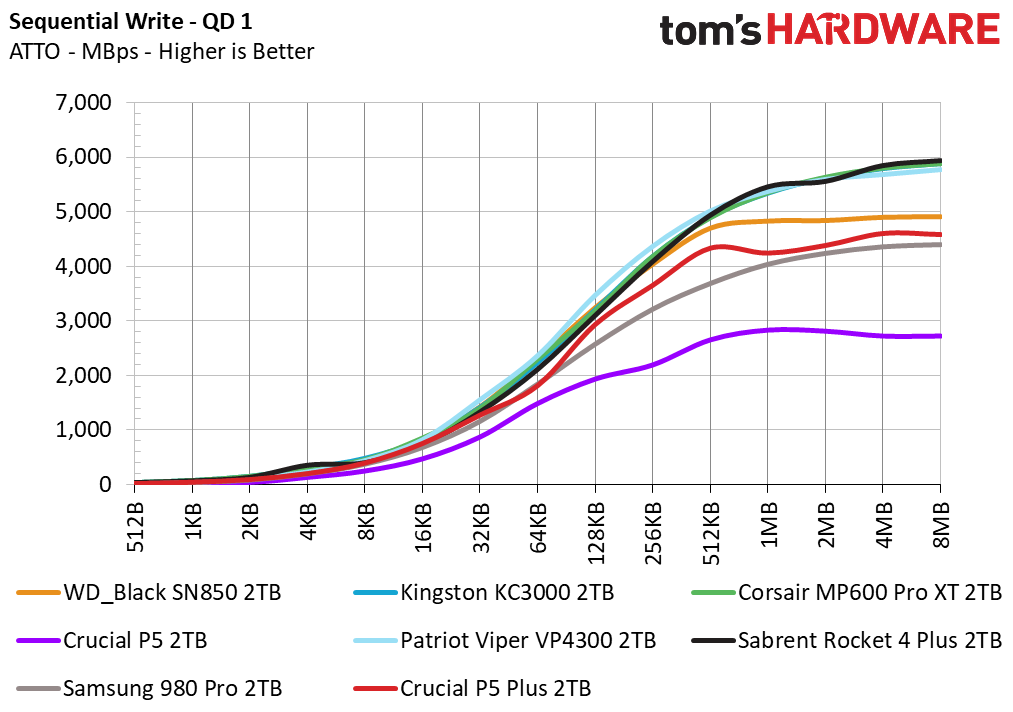






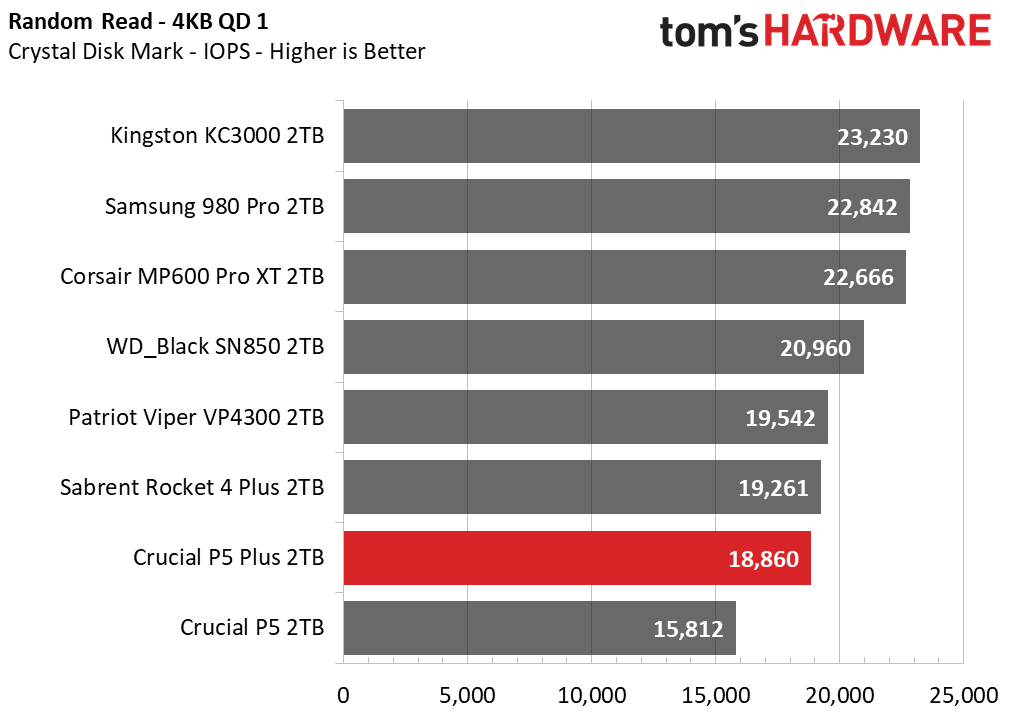

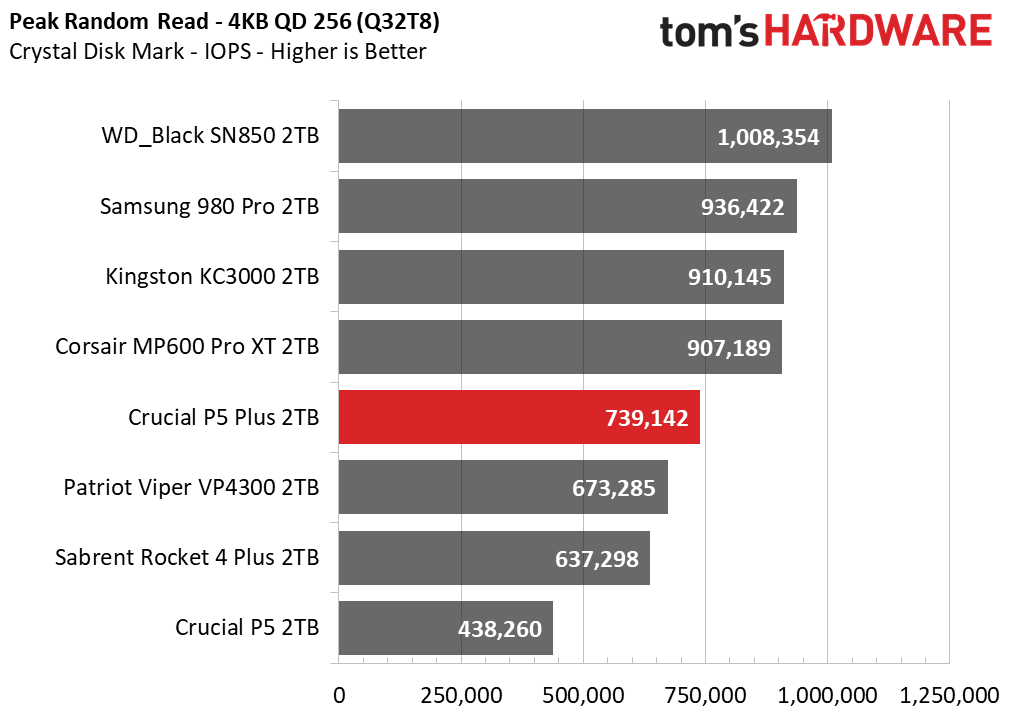

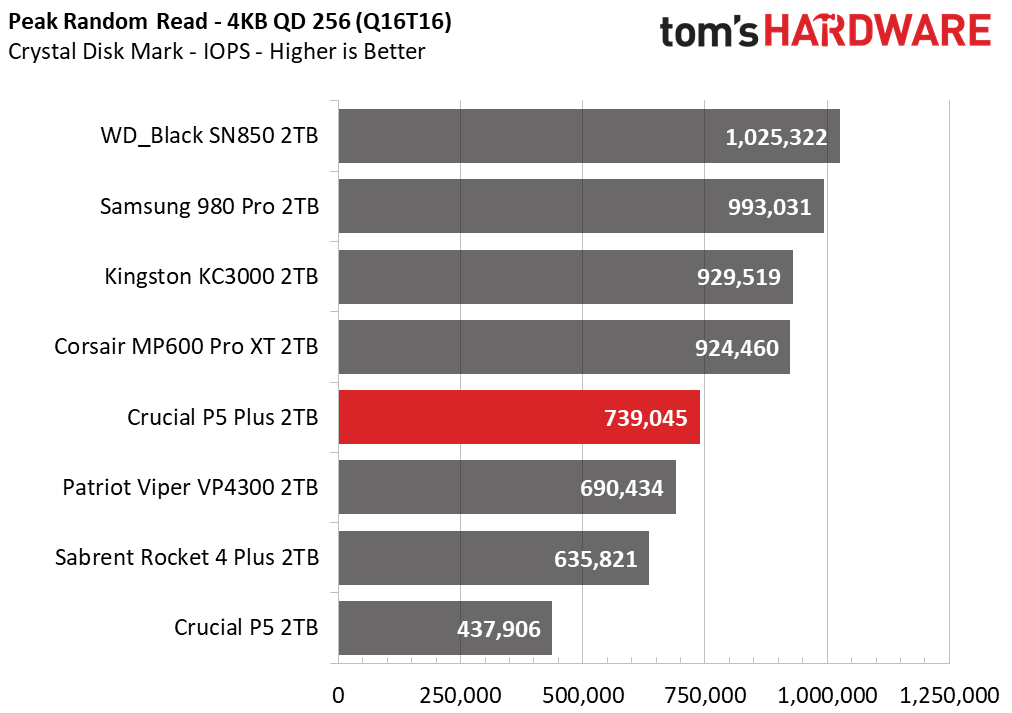

While the Phison E18-equipped competitors such as the KC3000 and Sabrent Rocket 4 Plus set the bar and delivered clean performance scaling across all our tested block sizes, Crucial’s P5 Plus was less consistent, and its write performance landed between the WD Black SN850 and Samsung 980 Pro. Although the P5 Plus delivered some of the fastest PCMark 10 results we have seen, it delivered some of the slowest 4KB random read/write times. In fact, the P5 Plus is only faster than the PCIe Gen3-based P5 in this test.
Sustained Write Performance and Cache Recovery
Official write specifications are only part of the performance picture. Most SSDs implement a write cache, which is a fast area of (usually) pseudo-SLC programmed flash that absorbs incoming data. Unfortunately, sustained write speeds can suffer tremendously once the workload spills outside the cache and into the "native" TLC or QLC flash. We use iometer to hammer the SSD with sequential writes for 15 minutes to measure both the size of the write cache and performance after the cache is saturated. We also monitor cache recovery via multiple idle rounds.





With double the capacity of the 1TB model, the 2TB P5 Plus comes with a dynamic SLC cache that measures twice as large. As a result, Crucial’s 2TB P5 Plus absorbed 200GB of data before degrading in performance from roughly 5.1 GBps down to 1.8 GBps for the remainder of the test. This performance gave it a solid empty-to-fill time, ranking fourth in the comparison pool. The SLC cache recouped roughly 150GB of capacity in each recovery round (ranging from 30 seconds to 30 minutes).
Power Consumption and Temperature
We use the Quarch HD Programmable Power Module to gain a deeper understanding of power characteristics. Idle power consumption is an important aspect to consider, especially if you're looking for a laptop upgrade. Some SSDs can consume watts of power at idle, while better-suited ones sip just milliwatts. Average workload power consumption and max consumption are two other aspects of power consumption, but performance-per-watt is more important. A drive might consume more power during any given workload, but accomplishing a task faster allows the drive to drop into an idle state more quickly, ultimately saving energy.
We also monitor the drive’s temperature via the S.M.A.R.T. data and an IR thermometer to see when (or if) thermal throttling kicks in and how it impacts performance. Bear in mind that results will vary based on the workload and ambient air temperature.
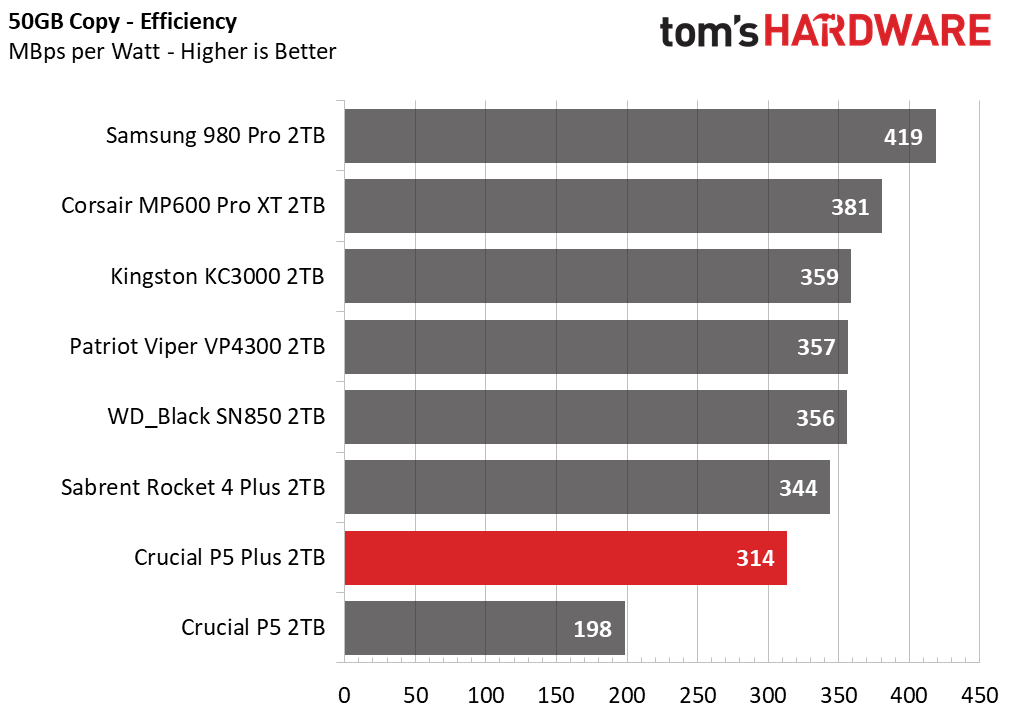



While it edges out ahead of Crucial’s P5, the P5 Plus lagged the PCIe Gen4 competitors, scoring second to last place in power efficiency under load. On average, it consumed similar levels of power as the Corsair MP600 Pro XT, but was a much bigger power hog at idle. The P5 Plus consumed roughly 1.3W of power at idle, leading to high idle temperatures on our test bench.
At idle, the controller measured roughly 55 degrees Celsius at idle in our 24-degree lab. Like the 1TB model, the P5 Plus is quite cool and doesn’t throttle under normal use cases. However, it began to throttle after we transferred roughly 800GB of data. At that point, the controller’s temperature measured 81 degrees Celsius and 76 degrees, as reported by the S.M.A.R.T. data.
Test Bench and Testing Notes
| CPU | Intel Core i9-11900K |
| Motherboard | ASRock Z590 Taichi |
| Memory | 2x8GB Kingston HyperX Predator DDR4 5333 |
| Graphics | Intel UHD Graphics 750 |
| CPU Cooling | Alphacool Eissturm Hurricane Copper 45 3x140mm |
| Case | Streacom BC1 Open Benchtable |
| Power Supply | Corsair SF750 Platinum |
| OS Storage | WD_Black SN850 2TB |
| Operating System | Windows 10 Pro 64-bit 20H2 |
We use an Intel Rocket Lake platform with most background applications such as indexing, windows updates, and anti-virus disabled in the OS to reduce run-to-run variability. Each SSD is prefilled to 50% capacity and tested as a secondary device. Unless noted, we use active cooling for all SSDs.
MORE: Best SSDs
MORE: How We Test HDDs And SSDs
MORE: All SSD Content
Current page: 2TB Performance Results
Prev Page Features and Specifications Next Page 1TB Performance Results
Sean is a Contributing Editor at Tom’s Hardware US, covering storage hardware.
-
mikewinddale "You also get integrated power loss immunity due to the way Crucial programs the flash.."Reply
That's huge for a consumer drive in a 2280 form factor. -
Howardohyea Gotta love competition, they put out some impressive products.Reply
If I have to say 2020-2021 is one of the best years as far as competition is concerned. AMD v Intel is reaching an all time high and Nvidia is having competition.
Not to mention hard drives, you can snag a very capable drive for cheap prices these days -
plateLunch StorageReview was able to lock up their P5 Plus under heavy load. They had to power cycle their system to regain access. Did you see anything like that?Reply -
seanwebster Reply
Not thus far. It handled everything I threw at it thus far. Even after writing to the P5 Plus for more than 4x it’s capacity during our write saturation testing, it reformatted fine and benchmarked as if nothing happened.plateLunch said:StorageReview was able to lock up their P5 Plus under heavy load. They had to power cycle their system to regain access. Did you see anything like that? -
Soul_keeper Is the Nand actually running at it's rated speed of 1,600 MTps on this SSD ?Reply
Or is it doing the same as the Seagate 530 at 1,200 MTps ? -
seanwebster Reply
Your guess is as good as mine. Unfortunately, Crucial would not disclose this information.Soul_keeper said:Is the Nand actually running at it's rated speed of 1,600 MTps on this SSD ?
Or is it doing the same as the Seagate 530 at 1,200 MTps ?

